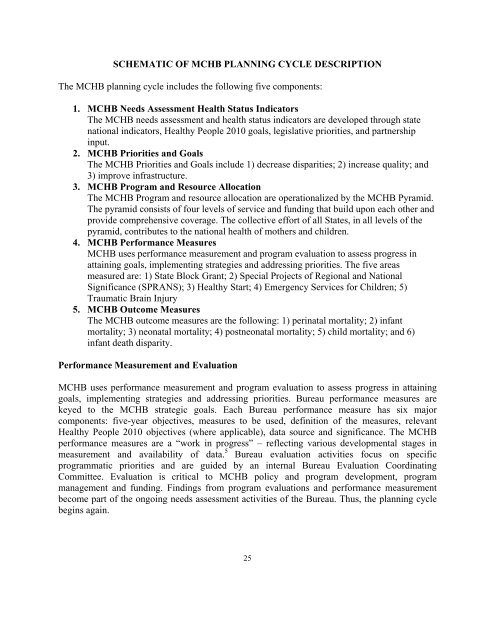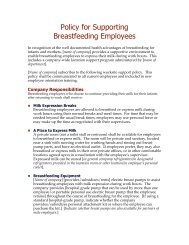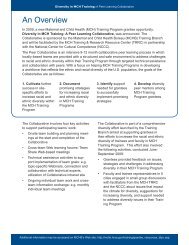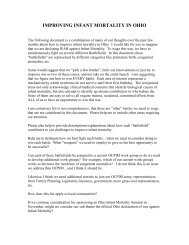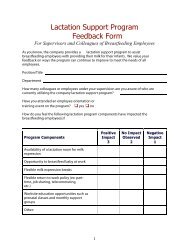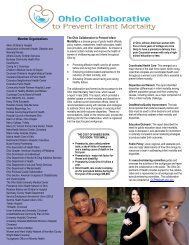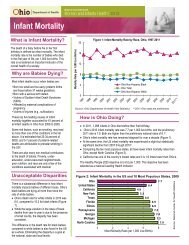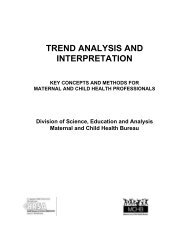MCHB Strategic Plan - Maternal and Child Health Bureau - HRSA
MCHB Strategic Plan - Maternal and Child Health Bureau - HRSA
MCHB Strategic Plan - Maternal and Child Health Bureau - HRSA
Create successful ePaper yourself
Turn your PDF publications into a flip-book with our unique Google optimized e-Paper software.
SCHEMATIC OF <strong>MCHB</strong> PLANNING CYCLE DESCRIPTIONThe <strong>MCHB</strong> planning cycle includes the following five components:1. <strong>MCHB</strong> Needs Assessment <strong>Health</strong> Status IndicatorsThe <strong>MCHB</strong> needs assessment <strong>and</strong> health status indicators are developed through statenational indicators, <strong>Health</strong>y People 2010 goals, legislative priorities, <strong>and</strong> partnershipinput.2. <strong>MCHB</strong> Priorities <strong>and</strong> GoalsThe <strong>MCHB</strong> Priorities <strong>and</strong> Goals include 1) decrease disparities; 2) increase quality; <strong>and</strong>3) improve infrastructure.3. <strong>MCHB</strong> Program <strong>and</strong> Resource AllocationThe <strong>MCHB</strong> Program <strong>and</strong> resource allocation are operationalized by the <strong>MCHB</strong> Pyramid.The pyramid consists of four levels of service <strong>and</strong> funding that build upon each other <strong>and</strong>provide comprehensive coverage. The collective effort of all States, in all levels of thepyramid, contributes to the national health of mothers <strong>and</strong> children.4. <strong>MCHB</strong> Performance Measures<strong>MCHB</strong> uses performance measurement <strong>and</strong> program evaluation to assess progress inattaining goals, implementing strategies <strong>and</strong> addressing priorities. The five areasmeasured are: 1) State Block Grant; 2) Special Projects of Regional <strong>and</strong> NationalSignificance (SPRANS); 3) <strong>Health</strong>y Start; 4) Emergency Services for <strong>Child</strong>ren; 5)Traumatic Brain Injury5. <strong>MCHB</strong> Outcome MeasuresThe <strong>MCHB</strong> outcome measures are the following: 1) perinatal mortality; 2) infantmortality; 3) neonatal mortality; 4) postneonatal mortality; 5) child mortality; <strong>and</strong> 6)infant death disparity.Performance Measurement <strong>and</strong> Evaluation<strong>MCHB</strong> uses performance measurement <strong>and</strong> program evaluation to assess progress in attaininggoals, implementing strategies <strong>and</strong> addressing priorities. <strong>Bureau</strong> performance measures arekeyed to the <strong>MCHB</strong> strategic goals. Each <strong>Bureau</strong> performance measure has six majorcomponents: five-year objectives, measures to be used, definition of the measures, relevant<strong>Health</strong>y People 2010 objectives (where applicable), data source <strong>and</strong> significance. The <strong>MCHB</strong>performance measures are a “work in progress” – reflecting various developmental stages inmeasurement <strong>and</strong> availability of data. 5 <strong>Bureau</strong> evaluation activities focus on specificprogrammatic priorities <strong>and</strong> are guided by an internal <strong>Bureau</strong> Evaluation CoordinatingCommittee. Evaluation is critical to <strong>MCHB</strong> policy <strong>and</strong> program development, programmanagement <strong>and</strong> funding. Findings from program evaluations <strong>and</strong> performance measurementbecome part of the ongoing needs assessment activities of the <strong>Bureau</strong>. Thus, the planning cyclebegins again.25


